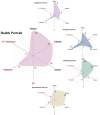Big Data-Driven Health Portraits for Personalized Management in Noncommunicable Diseases: Scoping Review
- PMID: 40472355
- PMCID: PMC12179573
- DOI: 10.2196/72636
Big Data-Driven Health Portraits for Personalized Management in Noncommunicable Diseases: Scoping Review
Abstract
Background: Health portraits powered by big data integrate diverse health-related data into actionable insights, thereby facilitating precise risk prediction and personalized management of noncommunicable diseases (NCDs). Despite their promise, the adoption and application of health portraits remain fragmented, primarily due to the lack of a standardized conceptual and methodological framework necessary to fully harness their capabilities.
Objective: This study aimed to systematically map and categorize existing research on health portraits in the context of NCD management, evaluate how big data has been used through the lens of the 3V (volume, velocity, and variety) framework, assess the extent of external validation and comprehensiveness, and identify challenges, emerging opportunities, and future research directions in this field.
Methods: A scoping review was conducted following the PRISMA-ScR (Preferred Reporting Items for Systematic Reviews and Meta-Analyses extension for Scoping Reviews) guidelines and 6-step framework of Levac et al. A comprehensive search was performed in PubMed, Embase, EBSCO, Ovid, Scopus, Web of Science, and Springer Link, focusing on observational and interventional studies using big data, public databases, electronic health record systems, wearables, and sensors for NCD management from January 2014 to July 2024. Data extraction included study characteristics, modeling approaches, and external validation. Analytical synthesis was conducted using keyword analysis, the 3V framework, and visual tools such as scatter plots, heat maps, and radar charts.
Results: A total of 8707 records were identified, and 89 studies were included for full-text analysis. These studies were categorized into 4 types of health portraits: diagnostic, prognostic, monitoring, and recommender. Evaluation based on the 3V framework showed that only 17.78% of studies met all 3 criteria. In terms of volume, structured data were widely used (64.29%-100% depending on portrait type), while unstructured data usage varied significantly (19.05%-93.33%). Regarding velocity, monitoring and recommender portraits showed high reliance on digital interactive data (over 85%). For variety, only 31.11% of studies incorporated all 3 data attributes (natural, domain, and specific attributes). In terms of comprehensiveness, only 30% of studies reported the external validation, and only 10% met both the external validation and 3V criteria, with recommender portraits outperforming the other types.
Conclusions: This study provides a standardized lens through which to evaluate the development and application of health portraits in NCD management. The findings underscore the need for more robust data integration strategies and emphasize the importance of artificial intelligence-enabled approaches. Furthermore, enhancing external validation and addressing ethical and privacy considerations are critical for advancing the implementation of personalized health management solutions.
Keywords: NCDs; big data; health portraits; management; non-communicable disease.
©Haoyang Du, Jianing Yu, Dandan Chen, Jingjie Wu, Erxu Xue, Yufeng Zhou, Xiaohua Pan, Jing Shao, Zhihong Ye. Originally published in the Journal of Medical Internet Research (https://www.jmir.org), 05.06.2025.
Conflict of interest statement
Conflicts of Interest: None declared.
Figures





Similar articles
-
Recent Advancements in Wearable Hydration-Monitoring Technologies: Scoping Review of Sensors, Trends, and Future Directions.JMIR Mhealth Uhealth. 2025 Jun 13;13:e60569. doi: 10.2196/60569. JMIR Mhealth Uhealth. 2025. PMID: 40513095 Free PMC article.
-
Applications of Large Language Models in the Field of Suicide Prevention: Scoping Review.J Med Internet Res. 2025 Jan 23;27:e63126. doi: 10.2196/63126. J Med Internet Res. 2025. PMID: 39847414 Free PMC article.
-
The development and use of data warehousing in clinical settings: a scoping review.Front Digit Health. 2025 Jun 5;7:1599514. doi: 10.3389/fdgth.2025.1599514. eCollection 2025. Front Digit Health. 2025. PMID: 40538572 Free PMC article. Review.
-
Use of Augmented Reality for Training Assistance in Laparoscopic Surgery: Scoping Literature Review.J Med Internet Res. 2025 Jan 28;27:e58108. doi: 10.2196/58108. J Med Internet Res. 2025. PMID: 39874568 Free PMC article.
-
The Use of Machine Learning for Analyzing Real-World Data in Disease Prediction and Management: Systematic Review.JMIR Med Inform. 2025 Jun 19;13:e68898. doi: 10.2196/68898. JMIR Med Inform. 2025. PMID: 40537090 Free PMC article.
References
-
- Bhuiyan MA, Galdes N, Cuschieri S, Hu P. A comparative systematic review of risk factors, prevalence, and challenges contributing to non-communicable diseases in South Asia, Africa, and Caribbeans. J Health Popul Nutr. 2024;43(1):140. doi: 10.1186/s41043-024-00607-2. https://jhpn.biomedcentral.com/articles/10.1186/s41043-024-00607-2 10.1186/s41043-024-00607-2 - DOI - DOI - PMC - PubMed
-
- Noncommunicable Diseases Progress Monitor 2022. 1st ed. World Health Organization. [2022-04-11]. https://www.who.int/publications/i/item/9789240047761 .
-
- Ben-Shlomo Y, Kuh D. A life course approach to chronic disease epidemiology: conceptual models, empirical challenges and interdisciplinary perspectives. Int J Epidemiol. 2002;31(2):285–293. - PubMed
-
- Shu J, Jin W. Prioritizing non-communicable diseases in the post-pandemic era based on a comprehensive analysis of the GBD 2019 from 1990 to 2019. Sci Rep. 2023;13(1):13325. doi: 10.1038/s41598-023-40595-7. https://doi.org/10.1038/s41598-023-40595-7 10.1038/s41598-023-40595-7 - DOI - DOI - PMC - PubMed
Publication types
MeSH terms
LinkOut - more resources
Full Text Sources
Miscellaneous

